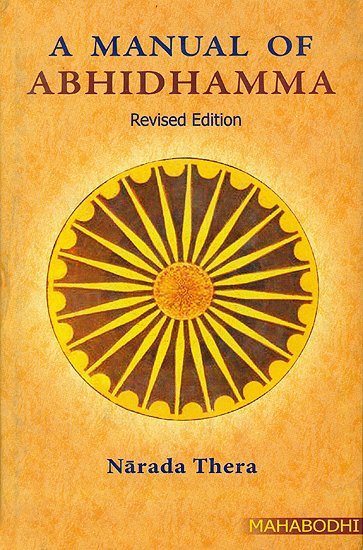A Manual of Abhidhamma
by Nārada Thera | 80,494 words | ISBN-13: 9789380336510
In the Abhidhammattha Sangaha there is a brief exposition of the Law of Dependent Origination, followed by a descriptive account of the Causal Relations that finds no parallel in any other philosophy. Edited in the original Pali Text with English Translation and Explanatory Notes by Narada Maha Thera....
§ 11. Katham?
- Lokuttaresu tāva atthasu pathamajjhānikacittesu Aññasamānā terasa cetasikā Appamaññāvajjitā tevīsati Sobhanacetasika c'āti chattimsa dhammā sangaham gacchanti.
- Tathā Dutiyajjhānikacittesu Vitakkavajjā.
- Tatiyajjhānikacittesu Vitakka-Vicāravajjā.
- Catutthajjhānikacittesu Vitakka-Vicāra-Pītivajjā.
- Pañcamajjhānikaccittesu'pi Upekkhāsahagatā te'eva sangayhanti'ti sabbathā' pi atthasu Lokuttaracittesu pañcadhā'va sangaho hotī'ti.
Chattimsa pañcatimsā ca-catuttimsa yathākkamam
Tettimsadvayam'iccevam - pañcadhānuttare thitā.
(translation)
§ 11. How?
- At first in the eight types of Supra mundane first Jhāna types of consciousness thirty-six factors enter into combination - namely, thirteen aññasamānas, and twenty-three Beautiful mental factors, excluding the two Illimitables[1] (13 + 23 = 36)
- Similarly in the Supramundane Second Jhāna consciousness, all the above, excluding Initial Application.[2]
- In the Third, (all those) excluding Initial Application and Sustained Application.
- In the Fourth, (all those) excluding Initial Application, Sustained Application, and Joy.
- In the Fifth Jhāna type of consciousness which is accompanied by Equanimity, all those excluding Initial Application, Sustained Application, Joy, and Happiness.
Thus in every way fivefold is the synthesis of mental factors arising in the eight types of Supra mundane consciousness according to the five Jhānas.
Respectively there are thirty-six, thirty-five, thirty-four, and thirty-three in the last two.
Thus in five ways they arise in the Supra mundane.
Notes:
52. Aniyatayogi and Niyatayogi -
Of the 52 types of mental states eleven are called aniyatayogi - unfixed adjuncts. They arise in different kinds of consciousness separately because their particular objects differ. They may or may not arise in those types of consciousness to which they are allied. For instance, issā, macchariya, and kukkucca must arise in a consciousness connected with aversion. One of the three must arise at one particular moment. All the three do not occur simultaneously. Besides they are not bound to be present in such a consciousness. So are the three Abstinences, two Illimitables, Conceit, Sloth and Torpor.
The remaining 41 types are called niyatayogi - fixed adjuncts. They invariably arise in those types of consciousness allied to them.
53. Abstinences -
These three are collectively found only in the Supra mundane consciousness, as they constitute three of eight factors of the Noble Path. They cannot arise in the rūpāvacara and arūpāvacara, nor in the kāmāvacara vipāka and kriyā cittas. They deal with three forms of refraining from committing evil through word, deed, and livelihood. As such they arise separately only in the eight types of moral consciousness according to the abstinence from the particular evil.
These Abstinences appear in full force only in the lokuttara-cittas, because the corresponding evils are completely eradicated by them. In the kāmāvacara-kusala-cittas there is only a temporary inhibition of evil.
As kāmāvacara-vipāka-cittas are merely effects they cannot arise in them. Since kriyā-cittas are experienced only by Arahats, they do not arise in them. In the rūpāvacara and arūpāvacara planes they do not occur because the need for moral purification, the function of these abstinences, does not arise there.
54. Illimitables (Sublime Abodes)-
Of the four only two are mentioned here. The other two have already been dealt with in their respective places.
It should be noted that the objects of these tables are beings. Therefore they cannot arise in the Supra mundane consciousness which has for its object Nibbāna. This does not mean that Arahats and other Aryans do not possess these virtues. They are not present only in the Path and Fruit consciousness.
They do not occur in the fifth Jhāna as it is accompanied by upekkhā - neutral feeling. In the arūpa-cittas also they do not arise as they also are connected with upekkhā. In the eight kiriya cittas, which the Arahats experience, they arise because the Arahats also radiate thoughts of karunā and muditā towards all beings.
Footnotes and references:
[1]:
Because their objects are living beings, while the lokuttara consciousness has Nibbāna for its object.
[2]:
Vitakka is eliminated in the 2nd Jhāna. The elimination of other factors in the remaining Jhānas should be similarly understood.
